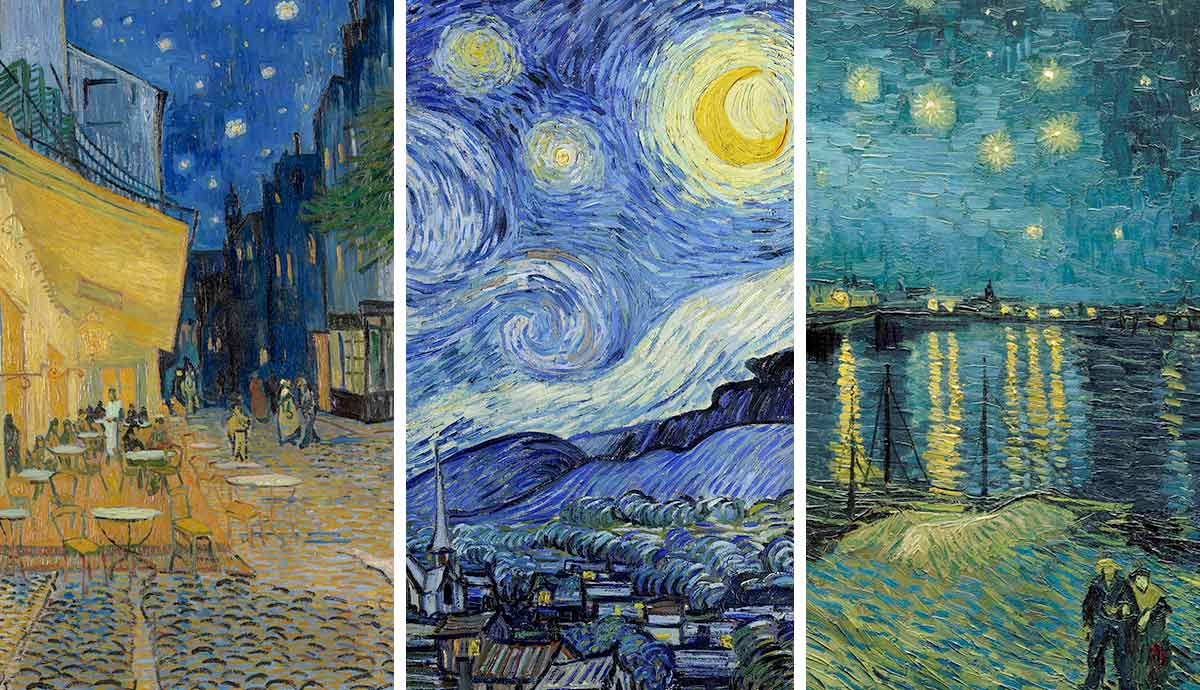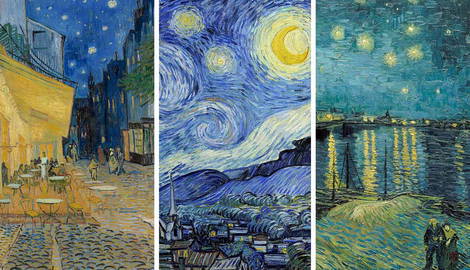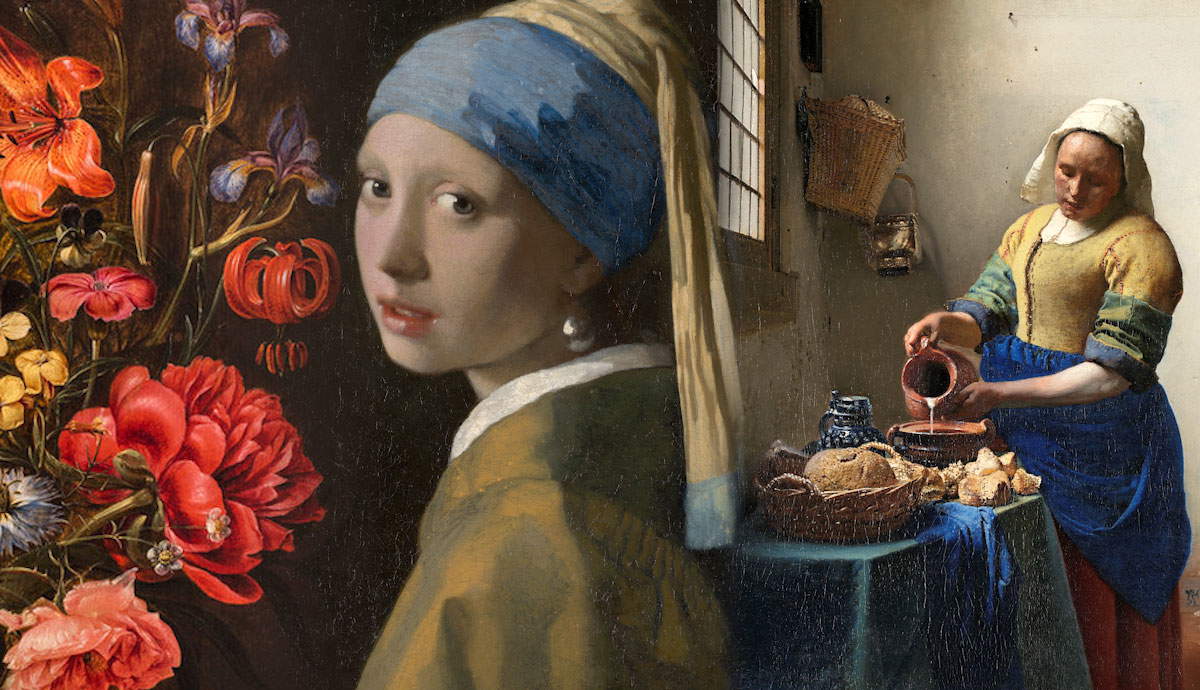
Vincent van Gogh (1853–1890) is today a globally renowned artist, but his lifetime was marked by profound struggles and limited recognition. Amidst immense personal adversities—from health issues to a tumultuous relationship with a fellow artist—Van Gogh proved extraordinarily prolific, completing over 2,000 artworks in just over a decade. Many of these now rank among the most famous paintings ever created. This article examines 10 pivotal Van Gogh paintings that every art lover should know.
1. Van Gogh’s Self-Portrait with Bandaged Ear

One of art history’s most infamous moments is Vincent van Gogh cutting off his own ear. It happened in December 1888, after a heated argument with Paul Gauguin in Arles, France. Suffering a psychotic episode, Van Gogh severed his left ear. Weeks later, he painted Self-Portrait with Bandaged Ear, one of just three self-portraits that reference his illness. Wearing a fur-lined cap, Van Gogh captured the bitter January cold and his inner turmoil. The painting also reflects his dashed dream of an artist’s studio in the south, the Yellow House, which he abandoned after Gauguin left.
Despite everything, Van Gogh continued to work. The background shows a painting in progress and a Japanese print—symbols of his commitment and inspiration. Eighteen months later, he died from a self-inflicted gunshot. Others memorialized him too: portraits by John Russell, Toulouse-Lautrec, Gauguin, Lucien Pissarro, and even his doctor, Paul Gachet.
2. The Potato Eaters

Van Gogh only turned to art at the age of 27, following a string of unsuccessful jobs. Early in his career, he was influenced by Dutch genre painting and used a palette of dark tones, a stark contrast to the famously colorful style he developed later. As he embarked on his new path in life, Van Gogh spent some time living near his parents in the small Dutch village of Nuenen. The rural landscape, farmers, and peasants were an inspiration for the fledgling artist, and he made several paintings of bucolic scenes.
To prove himself, Van Gogh began to work on his early masterpiece, The Potato Eaters. He wanted to create a showpiece and chose a complex composition that demonstrated his artistic skill. The scene depicts five peasants around a table eating their daily meal of potatoes. The bony hands and rough faces show the harsh reality of country life. The figures are painted in earthy colors, not unlike those of a freshly picked potato. It was the painting’s message and symbolic use of color that was important to Van Gogh, and he was pleased with the piece. However, Van Gogh’s brother and an artist friend were not impressed, criticizing the dark colors and mistakes in the figures.
3. Sunflowers

Sunflowers are synonymous with Van Gogh. His famous yellow flowers are some of the most iconic artworks of his career. He painted seven versions of Sunflowers, five of which are on display in public collections around the world. The first four of the series were created in August of 1888, just before Gauguin arrived at the Yellow House. Van Gogh was eager to please his guest, and so, knowing that Gauguin liked his earlier sunflower still lifes, he began to create his famous series. He hung two of the paintings in the guest bedroom, ready for Gauguin’s arrival.
He may have also chosen the flower for its symbolic nature. The sunflower has been associated with love for centuries, and for Van Gogh, this may have extended to friendship or artistic partnership. In the version of Sunflowers held by the National Gallery in London, there are 15 flowers at different stages of their life cycle. This stylistic choice reflects the vanitas tradition of using objects as reminders of mortality and the worthlessness of worldly goods, a popular device seen in 17th-century Dutch paintings.
4. Café Terrace at Night

Although Café Terrace at Night is a nocturnal painting, it is strikingly colorful. The scene shows the Café Terrace at The Place du Forum in Arles on a starlit night. The warm yellows and oranges of the gaslit street contrast with the deep blue of the heavens. Van Gogh created the painting in situ on the evening of September 16, 1888. He had an interest in astronomy and depicted the constellations exactly as they appeared in the sky that night.
It is thought that Van Gogh was inspired by Avenue de Clichy (Street—Five O’clock in the Evening), a painting by his friend Louis Anquetin (1861–1932). Anquetin’s work is also an evening street scene with a similar color palette of contrasting warm yellows and cool blues. Van Gogh certainly appreciated the work and included it in his Peintres du Petit Boulevard exhibition in 1887.
5. Starry Night Over the Rhône

Since his arrival in Arles, Van Gogh had been eager to create paintings with what he described as night effects. He wrote to both his brother, Theo, and his friend, Émile Bernard (1868–1941), about his desire to create a starry sky. Much of what we know about van Gogh comes from his correspondence with his brother Theo, who was an art dealer and well-connected in contemporary art circles.
Café Terrace at Night was his first attempt at night painting, which includes a patch of starlit sky. With Starry Night Over the Rhône, Van Gogh made the sky the centerpiece, creating a dazzling scene of the river Rhône under a sky ablaze with stars. He used an array of blues, including Prussian blue, ultramarine, and cobalt, to reproduce the colors as he saw them in the darkness. The gaslights and warm reflection of the lamps and stars in the water contrast with the deep blue of the night sky. This piece evokes a sense of serenity, enhanced by the lovers pictured in the bottom right corner of the canvas.
6. The Bedroom

In 1888, Van Gogh moved into the Yellow House, marking the first time that he had a home of his own. He decorated the house himself, painting several canvases to fill the walls. In October of that year, he created the first of three paintings of his bedroom. The Bedroom shows his simply furnished, but homely, bedroom, complete with his own artwork hung on the walls. Van Gogh aimed to express repose or relaxation with his use of color.
Some of the pigment has faded over time, and the walls and door, which were once a vivid purple, now appear as a pale blue. The flattened perspective and lack of shadows are deliberate choices, made to resemble a Japanese print. The artist was pleased with the result, commenting to his brother in a letter, “When I saw my canvases again after my illness, what seemed to me the best was the bedroom.”
7. Irises

Irises is one of several paintings depicting the purple flower. This particular piece was painted during the artist’s first week at the asylum in Saint-Rémy, to which he had voluntarily admitted himself seeking refuge from his illness. During his time at the asylum, the last year of his life, he executed almost 130 paintings.
Each flower is unique, attesting to the artist’s study and observation. The use of yellow, complementing the flowers’ purple, adds vibrancy and joy to the canvas. Van Gogh intended Irises to be a study and painted it from nature in the gardens of the asylum. It was his art dealer brother, Theo, who recognized the painting’s quality, calling it “a beautiful study full of air and life.” Theo submitted the work to the Salon des Indépendants in September 1889.
8. Wheatfield with Cypresses

Cypress trees became a recurring motif in Van Gogh’s work from 1888. In April of that year, he commented to his brother in a letter that he needed “a starry night with Cypresses or — perhaps above a field of ripe wheat.” He went on to realize both of these ambitions in his works Starry Night and Wheatfield with Cypresses. In the summer of 1889, Van Gogh created three versions of Wheatfield with Cypresses: two on the same scale and one smaller piece, which he gifted to his mother and sister.
He painted outdoors and wrote of working in the strong, cold wind of the South of France. This wind is evident in Van Gogh’s distinctive brushstrokes and swirls, animating the trees, fields of wheat, and clouds. Wheatfield with Cypresses is noted for its rich impasto—paint thickly applied to the canvas—and the artist cited Adolphe Monticelli (1824–1886) as an influence in using this technique. With this work, he was also responding to paintings by Gauguin and Bernard. Their works were increasingly moving away from Impressionism and towards abstraction.
9. Almond Blossom

Van Gogh had a deep appreciation for Japanese printmaking, amassing a collection of over 600 works. It was a significant source of inspiration for him, and the influence is clearly evident in Almond Blossom. Blossoming trees were one of his favorite subjects, and this was a particularly personal painting. He created it as a gift for his brother, Theo, and his wife to celebrate the birth of their son. They named Vincent Willem after his uncle.
Almond trees are among the first to flower in the spring. They symbolize new life, making them a fitting subject to celebrate the occasion. The Van Gogh family treasured the painting, which hung in their home for many years. Later, it became part of the collection of the Van Gogh Museum in Amsterdam, which was established by Vincent Willem.
10. Van Gogh’s Starry Night

Starry Night is arguably Van Gogh’s most famous work. The painting was inspired by the view from the artist’s window at the asylum in Saint-Rémy. It shows the night sky dramatically lit by the moon and bright stars, illuminating a small village at the foot of the hills and a cypress tree rising in the foreground. Van Gogh spoke of his inspiration for the painting in a letter to his brother. He wrote, “This morning I saw the countryside from my window a long time before sunrise, with nothing but the morning star, which looked very big.”
Rather than a direct representation of the view, the painting is a mixture of observation and imagination. Van Gogh incorporated memories and emotions. The church at the center of the composition resembles those found in the artist’s native Netherlands. The swirling brushstrokes that appear to roll across the canvas add a sense of turbulence to the scene. These contrast with the more tranquil feel of his earlier Starry Night Over the Rhône. Starry Night is a masterpiece of Post-Impressionism, a movement in which Van Gogh was a pioneer. His expressive brushstrokes and coloration imbue the painting with a profound sense of personal emotion, a defining feature of the movement.










